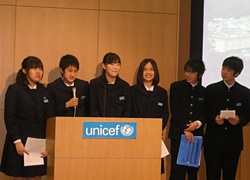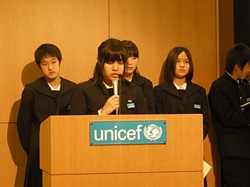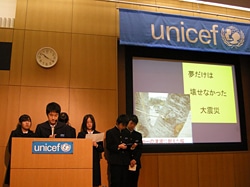



[TOKYO, JAPAN, 25 April 2013]
 |
On Thursday, 18 April students from Onagawa Junior High School visited the UNICEF House in Tokyo where they expressed their strong passion for life in the face of seemingly never-ending adversity.
In April, Onagawa Daiichi Junior High School and Onagawa Daini Junior High School merged to form the new Onagawa Junior High School. On this occasion, eight third-year students visited the UNICEF House to express their gratitude for the assistance provided by the Japan Committee for UNICEF (JCU) and their strong determination for the future.
Onagawa is a beautiful town set on the coast of Miyagi Prefecture with a rich aquaculture and marine product processing industries. The Great East Japan Earthquake and following tsunami of 11 March 2011, however, took the lives of 800 town residents and destroyed nearly 90% of the town's homes. The eight students who visited the UNICEF House were sixth-year primary school students at the time of the disaster. On 11 April 2011, one month following the disaster, the students were able to attend their junior high school entrance ceremony. Speaking about that occasion, one student said, "We had no school uniforms or stationery. However, we were given the things we needed to attend school, to live normal lives, and to get by, from UNICEF and so many other donors. That is why we want to do what we can as well."
 |
In the students' first social studies class following the disaster, their teachers asked them to think about what they could to for their community. The students began thinking of how they could restore their town to one that is able to protect its citizens. Discussions initially focused on escaping in the event of an earthquake, but one student pointed out that not everyone tries to escape. That student's grandfather was trying to convince neighbors refusing to flee to evacuate when he we taken by the tsunami. The students reconsidered their ideas about how to protect people from disasters and came up with three proposals which they refer to as "Protection for a Thousand Years".
 |
The Great East Japan Earthquake is said to only occur once in a 1,000 years. As such, it is in our interest to protect the lives of those who will face the same circumstances in 1,000 years from now. The students' strong support for this concept is apparent in the title for their proposal, "Protection for a Thousand Years".
The students closed their presentation by indicating that they want to contribute to the future protection of people, as their own survival depended on the great support from people all over the world.
The Japan Committee for UNICEF promotes child-friendly reconstruction planning so that the views and ideas of children are incorporated in the reconstruction process.
All photo credits: © Japan Committee for UNICEF